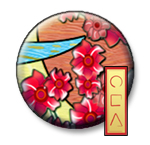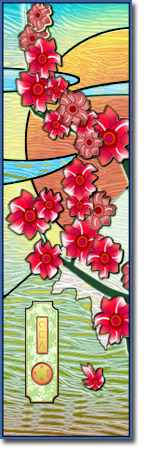On The Way: The Daily Zen Journal
Passing Through Barriers
Torei Enji (1721-1792)
In the present time, people often think that having no intellectual knowledge is Zen, and so they don’t use scriptures or treatises. Instead, they say, “What is the need for scriptures and treatises in the special transmission outside doctrine?” They still don’t realize that when what is outside doctrine is clear, what is in the doctrines doesn’t interfere; but if what is outside doctrine does not admit what is in the doctrines, then what is outside isn’t true either. Why? Because when a mirror is clear, it doesn’t select what to reflect; if reflections don’t appear, it means the mirror isn’t clear. You are rejecting the images of objects because of the dust covering the mirror.
If you are on the Great Way, you don’t conceive this opinion, especially since there are very deep meanings in the scriptures that can point out so many of your barriers of perception. It is only because your vision is not clear that you repudiate the golden words of the Buddha and cannot find out the hidden meanings in the scriptures that are hard to unlock.
It’s not a matter of making a religion of scriptures, just of using scriptures and treatises as revealing mirrors, using the teaching to reflect our own nature and using our own nature to reflect the teachings. Both must be clearly comprehended.
Scripture also says:
“People of the final age who do not comprehend the four appearances may practice the path with diligent intensity for eons, but this can only be called contrivance—in the end, they cannot attain all the realizations of sages. This is the reason it is called the final age of the true teaching. Why? Because the universal self is taken to be nirvana, and having realization and having enlightenment is called fulfillment.”
This is quite a lock—don’t misunderstand this passage and think it’s right to have no realization and no enlightenment. This scripture is based on realization of pure complete awareness. Therefore, it says, “If people of the final age hope to complete the Way, don’t let them seek enlightenment, as it will only increase their formal learning and magnify their opinion of themselves.”
Subsequently, it also uses four illnesses to illustrate sicknesses in perception, called construction, cessation, spontaneity, and extinction. The use of knowledge with a sense of understanding something is called the illness of construction. Going along with the nature of things, being spontaneous whatever happens, is called the illness of spontaneity. Stopping all perceptions so not a single thought arises is called the illness of cessation. Total annihilation and utter quietude without activity is called the illness of extinction.
Now tell me, how do you apply this in practice? Guifeng mistakenly made this interpretation: “Now the reason they are considered illnesses is because all four lack observing insight.” Wrong! Isn’t observing insight the substance of the illness of construction? He also says:
“Just because they induce the mind to dwell one-sidedly on one practice, failing to find out the whole meaning from good friends, and in their craving for simplicity hold to one and consider that completeness,  this is why the scripture denounces them all as illnesses. If you can master them all, without fixation on one, then you can enter the Way through all four.”
this is why the scripture denounces them all as illnesses. If you can master them all, without fixation on one, then you can enter the Way through all four.”
Wrong! Wrong! If you understand this way, what is the advantage? Even if you can comprehend all four principles and the complete meaning is distinctly clear, when you get here it’s like putting thorns in your eyes.
Scriptures such as these have been thoroughly annotated by followers of schools of intellectual interpretation who have all missed Buddha’s deep meaning. Zhenjing’s discourse on everyone realizing criticizes the raw; Heshan repudiates subjective explanation to warn students. So, if you want to read the ancient teachings, don’t use annotations. Annotations often obliterate the intent of the original text.
When students make use of their power to gradually progress along the road, none of them fail to find quite a few signs; then, all at once, they misuse their mind and think they have fully plumbed the source. Some rejoice, some rest, some open big mouths to explain for others, still unaware that they are just borrowing the power of the sayings to dress up and dignify their own views, and this is not the real meaning.
Just keep progressing, and do not stop halfway along. An ancient said, “Those who have attained have mold growing on their mouths.” Please keep your mouth shut for now and understand inwardly. Buddhism is not such and such a principle.
In the present time, there is also a type who tends to conceive easy views of the koans of the ancients. All alike they look at them and say, “An iron bar has no flavor—ah, ha, ha!” They’re like blind men asking about the color of milk: when told it’s like a conch, they interpret in terms of sound; told it’s like snow, they interpret in terms of cold. Now, an “iron bar” does not mean there is no flavor; it means there’s nothing you can get your teeth into—this is what’s called an iron bar. Just arouse an intense attitude of great fortitude where there is nothing to get your teeth into and chew vertically, chew horizontally, chew and chew unceasingly, and suddenly you’ll chew through. Once you’ve chewed through, you’ll find an inexhaustible flavor of Dharma in there. This is called an iron bar—later people didn’t understand and misinterpreted it to mean flavorless.
It is like the Flower Ornament’s great scripture in an atom—you cannot get it without breaking down the atom. So too is the iron bar—if you try to seek Buddhism without chewing through it, you’ll never succeed.
Torei Enji (1721-1792)
Excerpted from The Undying Lamp of Zen – The Zen Testament of Zen Master Torei trans by Thomas Cleary 2010





Like a good friend attempting to warn us of a hole we’re about to step into or a cliff we’re about to fall off of, Torei offers very practical advice for us. Who hasn’t known someone who disdains the study of sutras as examples of dogma and practiced their own version of Ma-tsu’s “everyday Mind is the Way?”
However, there are also challenges thrown down that are difficult to grasp. I’d be more suspicious if I read someone like him and thought I got it right away! The four illness or appearances are states we have all fallen for at times, thinking that indeed we were following the Way. Rather than reading through that passage assuming understanding, what about taking each line and trying to crack the kernel ourselves?
“The use of knowledge with a sense of understanding something is called the illness of construction.
Going along with the nature of things, being spontaneous whatever happens, is called the illness of spontaneity.
Stopping all perceptions so not a single thought arises is called the illness of cessation.
Total annihilation and utter quietude without activity is called the illness of extinction.”
Rather than accepting or rejecting at first glance, take each one and hold it up to a discerning eye to see all sides of what is being said. Each sentence becomes like a koan, that iron bar to chew and chew on until we break through.
Anyone who has read the original sutras can understand the need for annotation; however, it is true there is a risk of changing the material in translating itself and in commenting to assist in understanding. However, Buddha taught many different styles so as to reach many different people, each having their own way of hearing. There will be sutras that require many readings and others which seem to cause us to glaze over. Perhaps they were not written for us!
Just remember to “keep progressing, and do not stop halfway along.” What better advice than that can we hear?
Walking together,
Elana, Scribe for Daily Zen